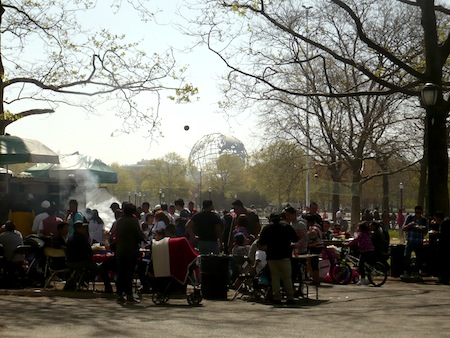We picked a sunny spring Sunday to visit Flushing Meadows Corona Park, the second-largest park in New York City. We had also, without realizing it, picked Cinco de Mayo. And where does the big Cinco de Mayo celebration in these parts take place? You guessed it: Flushing Meadows Corona Park.

In the next photo you can see the Unisphere in the distance behind the revelers. The little circle above and to the left of it isn't a newly acquired moonlet; it's a volleyball. (I carefully snapped this shot just as the ball arced into the air. Feel free to appreciate my extra effort to get the "action shot.")

And speaking of things arcing into the air and me reacting: the movie Iron Man 2 features a splendid fantasy re-creation of the Unisphere and the New York State Pavilion, the most famous of the structures that linger here from the 1964 World's Fair in various states of decrepitude. The Unisphere has been refurbished and looks fantastic, but it seems it hasn't made economic sense to do anything with the Pavilion and its famous floor mosaic. Presumably it will just crumble to ruin eventually.

Promoted by Robert Moses, the New York World's Fairs of 1939 and 1964  birthed this 1,255-acre park on what had once been a big expanse of more-or-less undeveloped meadows, then a dumping ground (F. Scott Fitzgerald's "valley of ashes"). Though it lacks the artistic landscaping of the great Olmstead and Vaux parks (like Central and Prospect), it's huge, heavily used, and highly valued by the people of Queens. Visitors from elsewhere find themselves on park grounds when they visit Citi Field to see the Mets, the USTA Billie Jean King National Tennis Center to see the U.S. Open, the New York Hall of Science, the Queens Museum of Art, or the Queens Wildlife Center (more humbly known as the Queens Zoo).
birthed this 1,255-acre park on what had once been a big expanse of more-or-less undeveloped meadows, then a dumping ground (F. Scott Fitzgerald's "valley of ashes"). Though it lacks the artistic landscaping of the great Olmstead and Vaux parks (like Central and Prospect), it's huge, heavily used, and highly valued by the people of Queens. Visitors from elsewhere find themselves on park grounds when they visit Citi Field to see the Mets, the USTA Billie Jean King National Tennis Center to see the U.S. Open, the New York Hall of Science, the Queens Museum of Art, or the Queens Wildlife Center (more humbly known as the Queens Zoo).
It's no surprise, then, that a proposal to build a new Major League Soccer stadium on the grounds has met with (I suspect futile) opposition from park lovers. So much of the space has already been eaten up by large facilities.
We entered from the east side, walking under the thundering traffic of the Van Wyck Expressway and the higher thunder of the jets out of LaGuardia Airport. A relatively peaceful strip of parkland greeted us, before we encountered the Cinco de Mayo crowds.


The southern section of the park, with Meadow Lake (NYC's largest lake) and Willow Lake, seemed to be inaccessible, or in any case we couldn't get to them through the festival crowds. We'll have to visit them another day. Industry Pond, from the World's Fair, was the only body of water we managed to visit.

The 43-foot Rocket Thrower, by Donald Delue, also dates from the 1964 World's Fair.

Here's a springtime view of the towers of the Pavilion through the trees:

Famed architect Philip Johnson designed the Pavilion, but his honored ghost has no power to get you into it or up into the towers any more. (Not if you're a civilian, anyway. A friendly NYPD officer told us she'd once been assigned to a police post up there during the U.S. Open tennis tournament.)
The round building on the left is the Queens Theatre, with the rusting rings of the Pavilion behind.

And this is just about as close as you can get to the Pavilion now:

Forgotten NY has more information on the past and present of the Pavilion. But you can see it for yourself, and the rest of this huge park, any day – even Cinco de Mayo.
No comments:
Post a Comment